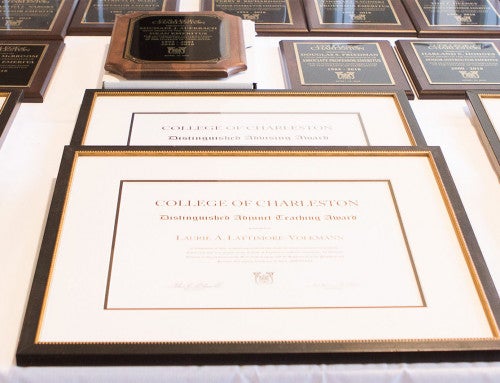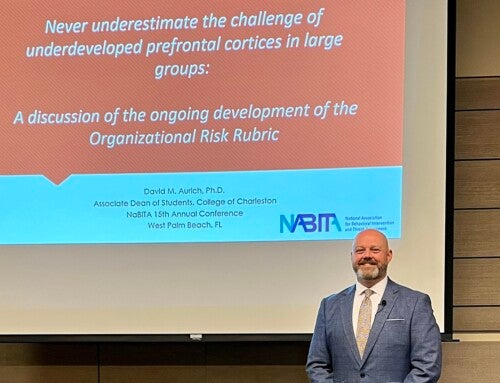On Thursday, April 2, 2020, Ed Pope, vice president of human resources and interim executive vice president for business affairs, issued the following announcement to College of Charleston employees:
CofC employees, below you will find additional information on two new paid leave options available only for those employees who are not able to work (on campus or remotely) due to the COVID-19 response. These apply to permanent and temporary employees. Affected employees who are not able to work and would like to apply for this leave need to submit an application using the links provided below.
Families First Coronavirus Response Act – Employee Guidance
On March 18, 2020, the “Families First Coronavirus Response Act” (FFCRA or Act) was signed into law. The FFCRA contains two different paid leave types related to the 2019 novel coronavirus (COVID-19) that apply to both permanent and temporary employees at the College of Charleston:
- Emergency Paid Sick Leave Act: Provides up to 80 hours of paid sick leave (prorated if part time) for employees for five qualifying reasons related to COVID-19.
- Emergency Family and Medical Leave Expansion Act (EFMLA): Expands the federal Family and Medical Leave Act to provide leave for employees who are unable to work, including work-from-home, as a result of having to care for a minor child due to a COVID-19 related closure of a school or child care center.
Both paid leave provisions take effect April 1, 2020, and both expire Dec. 31, 2020.
Emergency Paid Sick Leave Act
The Emergency Paid Sick Leave Act is a new, temporary form of leave that applies to both permanent and temporary employees at the College of Charleston. Employees may take up to 80 hours (prorated for part time) of emergency paid sick leave for one of the qualifying reasons outlined below. This includes employees who do not currently earn leave including temporary, temporary grant and time-limited employees. Employees are eligible from their first day of employment.
- What are the qualifying reasons for paid sick leave? The College may provide paid sick leave if the employee is unable to work (or work-from-home) because:
- The employee is subject to a Federal, State, or local quarantine or isolation order related to COVID–19.
- The employee has been advised by a health care provider to self-quarantine due to concerns related to COVID–19.
- The employee is experiencing symptoms of COVID–19 and seeking a medical diagnosis.
- The employee is caring for an individual who is subject to an order as described in paragraph 1 or has been advised as described in paragraph 2. Please note that the person being cared for does not have to be related to the employee for the employee to qualify for leave.
- The employee is caring for a son or daughter of such employee if the school or place of care of the son or daughter has been closed, or the child care provider of such son or daughter is unavailable, due to COVID–19 precautions
- Does Executive Order 2020-11 constitute a quarantine or isolation order? Yes, Governor McMaster’s Executive Order requiring that all non-essential state employees to not report to work constitutes a “Federal, State, or local quarantine or isolation order related to COVID-19.” Therefore, all employees who are unable to work-from-home and have been ordered not to report to the worksite would qualify for this leave.
- How many hours of paid sick leave can be taken? Full-time employees (those who are regularly scheduled to work 37.5 or 40 hours per week) are entitled to 80 hours of paid leave. The Emergency Paid Sick Leave Act requires that paid sick leave be provided for the hours the employee would have been normally scheduled to work even if that is more than 37.5 or 40 hours in a week. For example, an employee who is scheduled to work 50 hours a week may take 50 hours of paid sick leave in the first week and 30 hours of paid sick leave in the second week. In any event, the total number of hours paid under the Emergency Paid Sick Leave Act is capped at 80.
- Are part-time employees entitled to the same amount of leave? Part-time employees, including employees in part-time FTE positions, are entitled to paid leave for the number of hours equal to the number of hours that such employee works, on average, over a two-week period.
- Is the paid sick leave paid at the employees’ regular rate of pay? It depends on the reason for leave. If leave is taken for reasons 1-3 listed in the Act as noted below, the employee is paid their regular rate of pay up to $511.00 per day or $5,110 in the aggregate. If leave is taken for any other eligible reason (reasons 4-5 listed in the Act as noted below), the employee is paid two-thirds of the employee’s regular rate of pay up to a maximum of $200 per day and $2,000 in the aggregate. Employees can use any accrued leave to augment leave taken pursuant to the Emergency Paid Sick Leave Act up to their regular salary rate.
- Which qualifying reasons for leave are paid at the employees’ regular rate of pay up to $511.00 per day?
- The employee is subject to a Federal, State, or local quarantine or isolation orders related to COVID–19.
- The employee has been advised by a health care provider to self-quarantine due to concerns related to COVID–19.
- The employee is experiencing symptoms of COVID–19 and seeking a medical diagnosis.
- Which qualifying reasons for paid sick leave are paid at two-thirds the employees’ regular rate of pay to $200.00 per day?
- The employee is caring for an individual who is subject to an order as described in subparagraph 1 or has been advised as described in paragraph 2.
- The employee is caring for a son or daughter of such employee if the school or place of care of the son or daughter has been closed, or the child care provider of such son or daughter is unavailable, due to COVID–19 precautions.
- Does paid sick leave carry-over to next year? Leave may be used at any time between April 1-Dec. 31, 2020, and paid leave provided under the Act does not carry over from year to year.
- ***To apply for Emergency Paid Sick Leave, click HERE.
Emergency Family and Medical Leave Expansion Act (EFMLA)
The EFMLA amends and expands the federal Family and Medical Leave Act (FMLA), on a temporary basis, to provide qualifying employees up to 12 weeks of leave if the employee is unable to work, including work-from-home, due to the need to care for the employee’s child (under 18 years of age) if the child’s school or place of care is closed or the child care provider is unavailable due to a public health emergency.
- Who is eligible to take EFMLA? Employees are eligible to take leave under the EFMLA Act if they have been employed at least 30 calendar days. This includes employees in non-FTE and non-leave accruing positions. If the employee worked as a temporary, time-limited or temporary grant employee and was then transitioned to an FTE position, the total time worked in both positions should be added to determine if the 30-day timeframe has been met.
- Is EFMLA leave paid or unpaid? The first 10 workdays of the 12 workweeks of leave provided under the EFMLA are unpaid, but in accordance with standard FMLA administration, employees may use any paid leave available concurrently with EFMLA leave during this 10-day period. After the first 10 workdays, paid leave must be provided for the remaining leave taken under the EFMLA. This includes leave taken by employees who do not currently earn leave including temporary, temporary grant and time-limited employees.
- Is the leave paid at the employees’ regular rate of pay? The paid leave provided to eligible employees is calculated at two-thirds of an employee’s regular rate of pay and should be based on the number of hours the employee would otherwise be normally scheduled to work. Paid leave under the EFMLA is capped at $200 per day and $10,000 in the aggregate. Employees can use any accrued leave to augment leave taken pursuant to the EFMLA up to their regular salary rate.
- Does EFMLA leave carry-over to next year? Leave may be used at any time between April 1- Dec. 31, 2020, and does not carry over from year to year.
- How is 30 calendar days calculated for purposes of determining eligibility for EFMLA?An employee is considered to have been employed for 30 calendar days if the employee has been on payroll with any state agency for the 30 calendar days immediately prior to the day the leave would begin. This does not necessarily mean that the employee has actually worked 30 calendar days. If an employee has been working for an agency as a temporary employee, and the employee is subsequently hired into an FTE-position, the days previously worked as a temporary employee count toward this 30-day eligibility period.
- Are the 12 workweeks of leave provided under the EFMLA included in the 12 workweeks of leave provided by the FMLA? Yes. Employees are limited to a combined total of 12 weeks of leave taken under the EFMLA and FMLA during a calendar year. If an employee has already taken 12 workweeks of FMLA leave during the applicable 12-month period, they may not take additional leave under the EFMLA.
- ***To apply for Emergency Family and Medical Leave Act Expansion (EFMLA) Leave, click HERE.
General Information
- Can Emergency Paid Sick Leave or EFMLA leave be used for absences before April 1, 2020? No. Emergency Paid Sick Leave and EFMLA cannot be provided retroactively.
- Can employees take Emergency Paid Sick Leave or E-FMLA leave intermittently (i.e. in less than full-day increments) while working from home or the physical workplace? Yes, if an employee is unable to work their normal schedule of hours due to one of the qualifying reasons in the Emergency Paid Sick Leave Act. In that situation, the employee may take paid sick leave intermittently. Similarly, if the employee is prevented from working their normal schedule of hours because they need to care for their child whose school or place of care is closed, or child care provider is unavailable, because of COVID-19 related reasons, the employee can take expanded family medical leave intermittently.
- Are employees required to take other types of leave (e.g. annual leave, sick leave and family sick leave) before taking EFMLA leave or Emergency Paid Sick Leave? No. The College cannot require an employee to take other leave prior to taking Emergency Paid Sick Leave or EFMLA leave. The employee may, however, elect to use other leave to supplement the paid leave provided under the FFCRA in order to receive their full salary. Employees may also choose to use other types of leave available prior to taking emergency paid sick leave or EFMLA leave.
- If you have questions or need assistance with applying for the leave options described in this notice, please contact Sandy Butler ([email protected]) or Julie Birt ([email protected]) in Human Resources.



